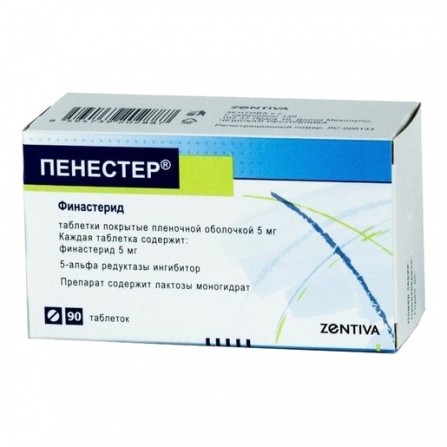Penester 0,005 N90 pills are film coated
Condition: New product
1000 Items
Rating:
Be the first to write a review!

More info
Active ingredients
Finasteride
Release form
Pills
Composition
Finasteride 5 mg.
Pharmacological effect
Finasteride is a synthetic 4-azasteroid compound. It is a specific competitive inhibitor of 5-alpha reductase type II - an intracellular enzyme that converts testosterone into an active androgen - dihydrotestosterone (DHT). With benign prostatic hyperplasia (BPH), its increase depends on the conversion of testosterone to DHT in the prostate. Finasteride highly effective reduces the concentration of DHT in both blood plasma and prostate tissue. The suppression of the formation of DHT is accompanied by a decrease in the size of the prostate gland, an increase in the maximum speed of urination and a decrease in the severity of symptoms associated with hyperplasia of the prostate gland. Finasteride has no affinity for androgen receptors. According to the results of a clinical study (PLESS), which involved patients with moderate or significantly severe symptoms of BPH and an enlarged prostate gland, finasteride reduced the incidence of acute urinary retention from 7/100 to 3/100 over a 4-year period, and the need for surgical intervention (transurethral resection of the prostate (TURP) or prostatectomy) - from 10/100 to 5/100. These changes were also associated with an improvement in the symptoms of BPH (a decrease of 2 points on the quasi-AUA symptom scale), a steady decrease in the volume of the prostate gland by about 20%, and a steady increase in the urine flow rate. A MTOPS (Medical Therapy Of Prostate Symptoms) study of 4 to 6 years, in which 3,047 men with symptoms of BPH were randomized to groups that received: finasteride at a dose of 5 mg / day. doxazosin in a dose of 4 mg / day or 8 mg / day. a combination of finasteride at a dose of 5 mg / day and doxazosin at a dose of 4 mg / day or 8 mg / day. or placebo. Treatment resulted in a significant reduction in the risk of clinical progression of BPH, which was 34% (p = 0.002), 39% (less than 0.001) and 67% (less than 0.001) compared to placebo when compared with finasteride. In most cases, the progression of BPH (274 out of 351) was manifested by exacerbation of the symptoms of BPH by more than 4 on the International Prostate Symptom Score (IPSS), while among patients who received finasteride, the risk of exacerbation of the symptoms, assessed by a point indicator, was reduced by 30% (95 % CI: 6-48%), among those receiving doxazosin - by 46% (95% CI: 25-60%), and among those receiving combination therapy - by 64% (95% CI: 48-75 %) relative to the placebo group.Among patients receiving finasteride, the risk of acute urinary retention was reduced by 67% (p = 0.011), in the group receiving doxazosin by 31% (p = 0.296), and in the group receiving combined therapy by 79% (p = 0.001 ) regarding the placebo group. A significant difference from placebo was observed only in groups of patients receiving finasteride and combination therapy.
Indications
Benign prostatic hyperplasia (to reduce the size of the prostate gland, increase the maximum rate of outflow of urine and reduce the symptoms associated with hyperplasia. Reduce the risk of acute urinary retention and the associated likelihood of surgical intervention).
Contraindications
Hypersensitivity, obstruction of the urinary tract, malignant tumor of the prostate.
Use during pregnancy and lactation
Use of the drug Penester is contraindicated in pregnancy and women of childbearing age. In connection with the ability of inhibitors of 5-alpha reductase type II to suppress the conversion of testosterone to dihydrotestosterone, these funds, including finasteride, when used in pregnant women, can cause abnormal development of the external genital organs in a male fetus. Finasteride is not indicated for use in women. There is no data on the excretion of finasteride with breast milk. Small amounts of finasteride were found in the semen of patients who received finasteride at a dose of 5 mg / day. Although there are no clinical data on the effect of finasteride on the male fetus, women of childbearing age should avoid contact with the seminal fluid of men taking finasteride. Women of childbearing age and pregnant women should avoid contact with damaged finasteride pills, since the ability of the drug to suppress the conversion of testosterone to dihydrotestosterone can cause a violation of the development of the genital organs in the male fetus.
Dosage and administration
The drug is administered orally 5 mg 1 time per day, regardless of the meal. The duration of therapy to assess its effectiveness should be at least 6 months. In approximately 50% of patients, the disappearance of clinical symptoms occurred during treatment for 12 months.
Side effects
On the part of the reproductive system: gynecomastia, breast tenderness, impotence, decreased libido and decreased volume of ejaculate. Other: allergic reactions.
special instructions
On the part of the reproductive system: gynecomastia, breast tenderness, impotence, decreased libido and decreased volume of ejaculate. Other: allergic reactions.




